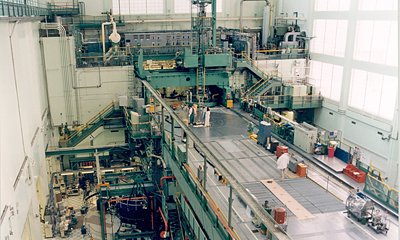
A longer-than-expected maintenance shutdown of the Canadian nuclear reactor that produces North America’s entire supply of molybdenum-99 — from which the radioactive isotopes technetium-99 and iodine-131 are made — has caused delays to the diagnosis and treatment of thousands of seriously ill patients.
Now in a surprise move the Canadian government has overruled the Canadian Nuclear Safety Commission (CNSC) — which is still concerned about the reactor’s safety — so that production can be restarted sooner.
The National Research Universal (NRU) reactor in Chalk River, Ontario, was closed down on 18 November for a planned five days of maintenance. However, Atomic Energy of Canada Limited (AECL), the government-owned company that owns the 50-year-old reactor, had to extend the shutdown amid concerns about its safety back-up equipment. On 7 December the company announced that the reactor would be unlikely to come back online until January 2008.
If the disruption continues much longer, our therapeutic capacity will also be compromised
By that point hospitals had begun to run short of the molybdenum isotope — which has a half-life of just 66 hours — forcing them to cut back on their technetium-based scans, which account for 75 to 80 per cent of the roughly 400,000 nuclear medicine scans carried out each week in North America. “Presently only the diagnostic aspect of nuclear medicine is affected,” the Canadian Society of Nuclear Medicine declared in a statement released on 6 December. “But if the disruption continues much longer, our therapeutic capacity will also be compromised.”
Radioactive isotopes tend to accumulate in particular organs in the body, and the radiation they emit can be used to produce images of these organs. Unlike purely structural scans such as CT, nuclear medicine provides radiologists with information about how well organs are functioning, since they can see how the isotope disperses and circulates. Tc-99 — which emits gamma radiation that is detected by a gamma camera — is used to, among other things, spot cancer and infections in bones and to monitor their healing. “A lot of therapy decisions are made on the basis of a nuclear medicine scan,” says Sandy McEwan, who is also chair of oncology and director of the imaging department at the Cross Cancer Institute in Edmonton, Alberta.
Alternative sources
Few alternative sources are available to compensate for the loss. Hospitals can use thallium-201 as an alternative to Tc-99 for cardiac imaging, but it yields images that are more difficult to interpret. The other three commercial producers of molybdenum-99 — in Belgium, the Netherlands and South Africa — have stepped up production but their capacity is insufficient to overcome the loss of NRU’s output as well as supplying the rest of the world.
As a result the medical community in North America has been exerting pressure on Canada’s government to restart production. On 11 December the Canadian parliament agreed a bill that temporarily suspends the CNSC’s oversight role, allowing the reactor to start up again even though it still does not fully meet safety standards. The AECL can now complete the rest of the maintenance work while the reactor is in operation, which it expects to take around 16 weeks. A date for the restart has not yet been announced.
The next time the NRU needs to be shut down for maintenance work the AECL should be prepared. It has built two new reactors, MAPLE 1 and MAPLE 2, for exclusive production of medical isotopes, which will have the capacity to meet the world’s entire needs for Mo-99 and other medical isotopes. Originally scheduled to go online in 2004, they are now due to start up in October 2008 and October 2009 respectively.



